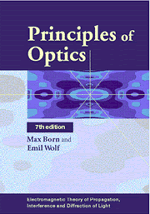Book contents
- Frontmatter
- Preface to corrected reprint of the seventh edition
- Preface to the first edition
- Preface to the second edition
- Preface to the third edition
- Preface to the fourth edition
- Preface to the fifth edition
- Preface to the sixth edition
- Preface to the seventh edition
- Contents
- Historical introduction
- I Basic properties of the electromagnetic field
- II Electromagnetic potentials and polarization
- III Foundations of geometrical optics
- IV Geometrical theory of optical imaging
- V Geometrical theory of aberrations
- VI Image-forming instruments
- VII Elements of the theory of interference and interferometers
- VIII Elements of the theory of diffraction
- IX The diffraction theory of aberrations
- X Interference and diffraction with partially coherent light
- XI Rigorous diffraction theory
- XII Diffraction of light by ultrasonic waves
- XIII Scattering from inhomogeneous media
- XIV Optics of metals
- XV Optics of crystals
- Appendices
- I The Calculus of variations
- II Light optics, electron optics and wave mechanics
- III Asymptotic approximations to integrals
- IV The Dirac delta function
- V A mathematical lemma used in the rigorous derivation of the Lorentz-Lorenz formula (§2.4.2)
- VI Propagation of discontinuities in an electromagnetic field (§3.1.1)
- VII The circle polynomials of Zernike (§9.2.1)
- VIII Proof of the inequality |μ12(v| ≤ 1 for the spectral degree of coherence (§10.5)
- IX Proof of a reciprocity inequality (§10.8.3)
- X Evaluation of two integrals (§12.2.2)
- XI Energy conservation in scalar wavefields (§13.3)
- XII Proof of Jones' lemma (§13.3)
- Author index
- Subject index
VI - Propagation of discontinuities in an electromagnetic field (§3.1.1)
from Appendices
- Frontmatter
- Preface to corrected reprint of the seventh edition
- Preface to the first edition
- Preface to the second edition
- Preface to the third edition
- Preface to the fourth edition
- Preface to the fifth edition
- Preface to the sixth edition
- Preface to the seventh edition
- Contents
- Historical introduction
- I Basic properties of the electromagnetic field
- II Electromagnetic potentials and polarization
- III Foundations of geometrical optics
- IV Geometrical theory of optical imaging
- V Geometrical theory of aberrations
- VI Image-forming instruments
- VII Elements of the theory of interference and interferometers
- VIII Elements of the theory of diffraction
- IX The diffraction theory of aberrations
- X Interference and diffraction with partially coherent light
- XI Rigorous diffraction theory
- XII Diffraction of light by ultrasonic waves
- XIII Scattering from inhomogeneous media
- XIV Optics of metals
- XV Optics of crystals
- Appendices
- I The Calculus of variations
- II Light optics, electron optics and wave mechanics
- III Asymptotic approximations to integrals
- IV The Dirac delta function
- V A mathematical lemma used in the rigorous derivation of the Lorentz-Lorenz formula (§2.4.2)
- VI Propagation of discontinuities in an electromagnetic field (§3.1.1)
- VII The circle polynomials of Zernike (§9.2.1)
- VIII Proof of the inequality |μ12(v| ≤ 1 for the spectral degree of coherence (§10.5)
- IX Proof of a reciprocity inequality (§10.8.3)
- X Evaluation of two integrals (§12.2.2)
- XI Energy conservation in scalar wavefields (§13.3)
- XII Proof of Jones' lemma (§13.3)
- Author index
- Subject index
Summary
IT was mentioned in §3.1.1 that the eikonal equation of geometrical optics is identical with an equation which describes the propagation of discontinuities in an electromagnetic field. More generally, the four equations §3.1 (lla)-(14a) governing the behaviour of the electromagnetic field associated with the geometrical light rays may be shown to be identical with equations which connect the field vectors on a moving discontinuity surface. It is the purpose of this appendix to demonstrate this mathematical equivalence.
Relations connecting discontinuous changes in field vectors
In §1.1.3 we considered discontinuities in field vectors which arise from abrupt changes in the material parameters £ and fi, for example at a surface of a lens. Discontinuous fields may also arise from entirely different reasons, namely because a source suddenly begins to radiate. The field then spreads into the space surrounding the source and with increasing time fills a larger and larger region. On the boundary of this region the field has a discontinuity, the field vectors being in general finite inside this region and zero outside it. We shall first establish certain general relations which hold on any surface at which the field is discontinuous. For simplicity we assume that at any instant of time t > 0 there is only one such surface; the extension to several discontinuity surfaces (which may arise, for example, from reflections at obstacles present in the medium) is straightforward.
- Type
- Chapter
- Information
- Principles of OpticsElectromagnetic Theory of Propagation, Interference and Diffraction of Light, pp. 901 - 904Publisher: Cambridge University PressPrint publication year: 1999



